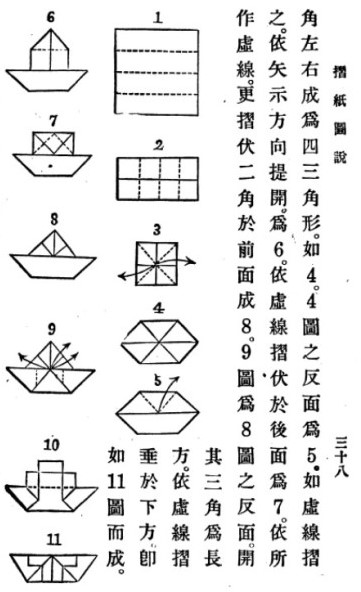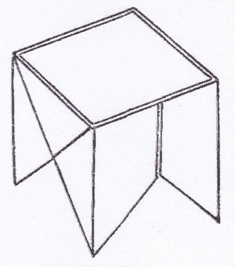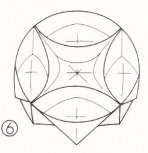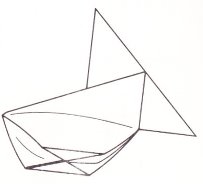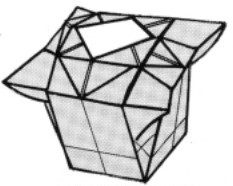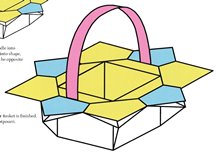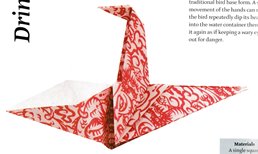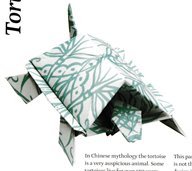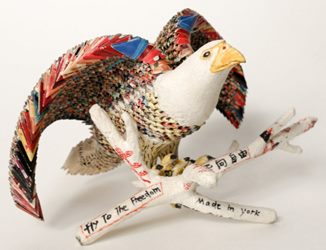| The Public Paperfolding History Project
x |
|||||||
| A Brief History of Educational and Recreational paperfolding in China after Cross-Fertilisation (1903 onwards) | |||||||
A: The introduction of kindergarten education from Japan In their paper 'Early childhood education and care in China: history, current trends and challenges', available online here (academic login required), the authors, Xiaofei Qi and Edward C. Melhuish, state that 'The first formal public kindergarten in China was built in 1903 by the then governor Duanfang in Hubei province. The kindergarten employed a Japanese headmaster and teachers and the curriculum was much influenced by the Japanese tradition. Later, in 1904, the first regulations regarding preschool education were introduced, mainly based on Japanese kindergarten regulations from 1900.' According to 'Schooling for Early Childhood: The Chinese Kindergarten in its Adolescence' by Yeh Hsueh, Joseph J. Tobin and Mayumi Karasawa (published in Prospects, vol. XXXIV, no. 4, December 2004 and available online here): 'At the turn of the twentieth century in a few coastal cities, there were a handful of foreign church-run kindergartens based on Froebelian models. But China’s first organized childcare and early education programmes did not begin until 1904, when the central government formally recognized a local government-supported kindergarten called mengyangyuan in Wuchang, a major port city on the Yangtze River, later known as Wuhan. This first Chinese kindergarten in China was based on a Japanese model inspired by Froebelian principles and practices. The three Japanese women who managed this mengyangyuan introduced a Japanese curriculum, teaching materials and cultural practices, including the Japanese language. This early, colonialist version of early childhood education in China was embraced mostly by well-to-do Chinese families and had little or no impact on the overall education system (Chen, 1996). In the first decade of the twentieth century a dozen governmental and private mengyangyuan appeared in Beijing, Shanghai, Tianjin and some other cities (Chen, 1996; Zheng, 1996; Chen & Liu, 1999). But it was not until the 1920s and the 1930s that the first major kindergarten development in China caught on, when a group of Chinese educators began actively promoting progressive educational ideas from the United States.' It should be noted that there is no specific mention of paperfolding in these sources, but we are, I think, fairly safe in assuming that some Japanese and Western European paperfolding designs would have been introduced into China as part of the kindergarten syllabus from around 1904 onwards. ********** B: Early 20th Century Paperfolding Manuals We have copies of two early paperfolding manuals, 'Zhe zhi tu shuo' by Gui Shaolie, published in Shanghai in 1914 and its follow-up, 'Xu zhe zhi tu shuo' by Yongxiang Shi, published in Shanghai in 1917. These are not kindergarten manuals but are aimed at elementary school teachers, the idea that paperfolding should be taught as a handicraft in elementary school to promote the development of fine motor skills having apparently also been introduced into China from Japan. As would be expected if this were true, many of the designs in these manuals are of either Western European and/or Japanese origin. There are, however, a considerable number of designs which are not previously known from either Western Europe or Japan and which may therefore be presumed to have originated in China. Among these previously unknown designs are the Carrier Pigeon, the Pavilion / Pagoda, the Clothes Drying Boat and the Armchair (from 'Zhe zhi tu shuo') and the Boatside Eagle, the Inflatable Rabbit, and the Lighthouse Bookmark (from 'Xu zhe zhi tu shuo').
The 'Clothes Drying Boat' from 'Zhe zhi tu shuo' It seems likely that these previously unknown designs were created after the introduction of kindergarten education from Japan, but we cannot, of course, absolutely rule out the idea that some may have been in existence, but undocumented, before this time. ********** D: 'The Art of Chinese Paper Folding' by Maying Soong The book 'The Art of Chinese Paper folding for Young and Old', by Maying Soong, was published in New York in 1948. According to David Lister (see here) the information in the original 1948 edition states that 'Maying Soong came from a distinguished pre-communist Chinese banking family. They were as much at home in the West as in China and Mme Soong received a British education in Shanghai. One of her main interests was music. She studied further in England, France and Switzerland. After the Communist take-over, Maying Soong settled in the United States. She married a brother of Mme Chiang Kai-Chek , the wife of the Chinese leader, who was forced out by the Communists and who continued to govern in Taiwan.' This book contains some of the previously unknown designs found in the two early 20th century paperfolding manuals detailed above and some other designs of Japanese or Western European origin, as well as a table and two hats which are not previously known from any other source.
The 'Table' from 'The Art of Chinese Paper Folding' by Maying Soong David Lister also states 'Some years ago I was bold enough to write to Mme. Soong and received a charming letter in reply. She confirmed that some of the models in her book were her own design'. However, we do not know which of the designs she was referring to here. ********** E: Designs of apparent Chinese origin 'discovered' in the modern era There are several now well-known designs which were first published / 'discovered' in a Chinese context in the modern era. These designs may, of course, be far older than the date at which they first became known in the West. As far as I know, however, there is no evidence for the existence of any of these designs prior to 1904. This design first appears in 'The Best of Origami: New Models by Contemporary Folders' by Samuel Randlett, which was published in New York in 1963, where the text says:.
********** This design first appears in Issue 23 of the periodical 'The Flapping Bird' which was published in 1974, where it is just called 'The Goldfish'. The text notes that this design was discovered by Philip Shen 'in the pages of the Hong Kong periodical 'Children's Paradise' but does not give a date for this discovery.
********** iii. Verdi's Vase Diagrams for this design were first published in the Fall 1989 edition of 'The Newsletter for The Friends of The Origami Center of America' which also contained an obituary for Verdi Adams, after whom the design is named, because he taught it so frequently. The diagrams state that it is a 'traditional Chinese design' collected by Philip Shen, but there is no information as to when and where it was collected.
********** iv. The Shanghai Star and Basket This modular design first came to the attention of paperfolders in the West after it was found in 1989 lying on the floor of the Shanghai Arts and Crafts Centre by the Hawaiian paperfolder, Marcia Mau, who was on a visit to China at the time. No other information about the origin of the design is known.
*********** v. The Drinking Bird This action design was taught to the American paperfolder Laura Kruskal in Beijing in 1989 by one of her English language students. It was previously unknown in the West.
********** vi. The Tortoise The origin of this design is a mystery. It appeared in the West, as far as I can remember, sometime in the 1990s, and is said to be of Chinese origin. Francis Ow once told me that he remembered folding it in the 1950s, but I have not managed to find any documentation to confirm this date, or its alleged Chinese origin.
********** E: 'Er Tong Zhe Zhi' Information about this topic will be added in due course ********** C: Golden Venture / 3D Origami This style of modular paperfolding, which uses a single type of simple module to create numerous complex forms, and which is probably of Chinese origin, first came to the attention of paperfolders in the West following the arrival, and deliberate stranding, of the vessel 'Golden Venture' in New York Harbor on 6th June 1993. The ship held 286 Chinese citizens, mostly from the Fujian province of China, who hoped to claim asylum in the USA. The US immigration authorities incarcerated them in various East Coast prisons where many remained in custody for up to 4 years. Whilst incarcerated, some of these asylum seekers created sculptures out of whatever materials were to hand, many of which included elements made using this single type of module, as well as, for instance, papier mache and other modelling techniques. Many of these sculptures were exhibited and/or sold to raise funds for the asylum seekers.
Golden Venture sculpture. 1995. Multi-media: Folded paper units, cardboard, papier-mâché. From Museum of Chinese in America (MOCA) Collections. Around the same time books of designs for 3D Origami sculptures began to appear in Japan and the West. It is not clear whether this technique was a new invention or whether it had simply become more widely known at this time. ********** |
|||||||
